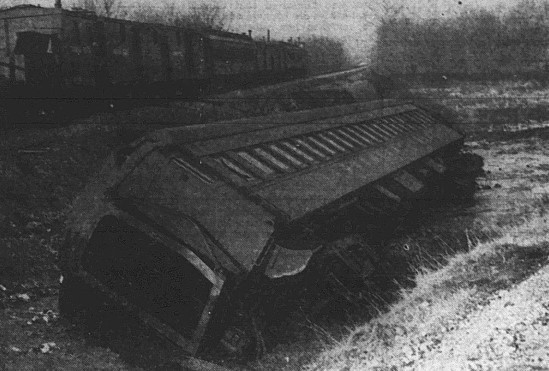The Zorra Train Wreck of 1945
The Zorra Train Wreck of 1945

Looking east towards the station, the line of derailed cars that remained on the right-of-way after other coaches plunged down the
10ft embankment - The Woodstock Daily Sentinel Review, 1945.
Passengers reported feeling a few bumps before the lights went out and the train derailed, sending two of the coaches down a steep 10 foot embankment and landing a good distance from the tracks where one coach burrowed into the ground and the other partially submerged in drainage water. Passengers remained calm even though they were thrown around inside the train cars and were buried under other passengers, luggage, and seats. Some of the passengers escaped the derailed cars by climbing out open windows or punching out windows. Servicemen and women on board, including nurses, quickly took charge of the situation assisting those in need and applying first aid. One witness stated that a civilian nurse and a Navy nurse (names unknown) were particularly vital to the rescue efforts.

One of the two combination cars that plunged down the embankment - The Woodstock Daily Sentinel Review, 1945.
It took hours to extricate the 80 injured passengers who were transported by Bluebird coaches, taxis and ambulances to Woodstock and Ingersoll hospitals, the uninjured passengers were taken to London on a relief train. Eye witnesses described the scene of the wreck as one of “utter confusion and horror” so you may be surprised to learn there were no fatalities. Mrs. Elizabeth Hall of Toronto had the most serious injuries of those taken to the Woodstock Hospital and was one of two passengers in critical condition. A list of injured passengers was published in the newspaper after the accident. Injuries ranged from fractured ribs and skulls; knee, hip and spine injuries, to cuts and bruises. Had the train cars been made from wood rather than steel the outcome of this accident likely would have been much different and more severe.

